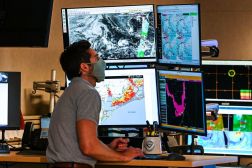Daniel McCrae, director of the the National Oceanic and Atmospheric Administration’s Service Delivery Division, said a good mobile strategy goes beyond the hardware itself.
McCrae, who manages a mobility system that helps NOAA process 3.5 billion daily operations often from ships and planes stationed around the world, said mission focus should be the ultimate guideline for developing an agency’s mobility plan.
“I would look at it not from from a mobile strategy but a workforce strategy,” McCrae said Wednesday at a cloud computing workshop. “We tend to look at this as a problem in search of an IT solution, it’s not that. We need to get [human resources] around the table, workforce management to the table and design capabilities for goals and objectives.”
McCrae said an IT department really should act more as a business consultant when considering mobility options, tying requirements to solutions and effectively communicating a purchasing plan to an acquisition team.
“One of the challenges is being able to articulate what it is you want to go buy,” he said. “You can’t have the deli mentality of just saying ‘I’ll have a pound of cloud, half a pound of mobile device management and gimme a little taste of that workplace-as-a-service,’ and put that in an acquisition package and expect to get something that’s going to be what you need.”
McCrae also spoke about mobility challenges past the acquisition process, highlighting how agencies should weigh a program’s success on more than just a cost-benefit evaluation.
“One of the challenges across the cost-benefit analysis is how do you measure the productivity associated with mobile?” McCrae said. “I don’t know if we have the right performance metrics identified to figure this out, so it’s easy to do arithmetic and add up all your infrastructure in your head, and say ‘This is how much that costs us.’ The other side is that equation, which is what we are still struggling with, is ‘What is the benefit that can be derived from those investments?'”
Another place where McCrae sees an opportunity for a new way of thinking is in the security that comes with a mobility plan. Again, McCrae said agencies should look past the actual hardware and more toward the policy associated with the plan.
“If we have a [mobile device management system] where we can define policies, that’s not difficult in and of itself,” McCrae said. “The challenge is what are the organizational governance elements that come to bear on what your security policy should be. What types of data are you going to permit to wander around on a mobile device that can be used by somebody at home? The hard lesson learned is to make sure you’ve got the governance and policy pieces in place before you go acquire a technology solution, because once you start rolling that thing out, you’re gonna quickly find that with the absence of governance, you kind of make it up as you go along and that’s not a good position to be in.”
Whatever the aspect, McCrae said that listening to employees on what tools they need will ultimately lead to a solid mobility plan and a fulfilled mission.
“We need to really understand the mission,” he said. “The mission is clear to the people that are doing it and employees have really good ideas about how to get the job done. We as IT professionals need to make sure we have a clear understanding of what that is and what the expectations are on the part of the employee. Every solution we design and deliver needs to align with the mission, reduce our risk footprint and deliver taxpayer value.”





